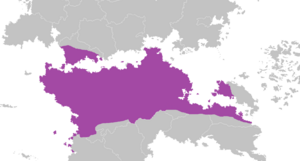Symmerian Empire: Difference between revisions
| Line 60: | Line 60: | ||
==History== | ==History== | ||
Historians use the ascension of [[Orestes II]] in 246 BCE as a dividing mark between [[Ancient Makedon]] and the Makedonian Empire, which saw Makedon rise from a local power in [[Syara]] to the premier power of Siduri. The change from kingdom to empire was recognized by the Makedonians as a change in government or society, and continued to refer to their domain simply as the "Realm" of Makedon. | |||
By the third century BCE Makedon had been placed in a position of power relative to the other Syaran nations, namely the [[Kydonian League]] and [[Galania]]. Orestes made clear his intention to conquer Syara and beyond shortly after taking the throne, a move which was opposed by his older brother Lycklos, who was killed by Orestes in response. Orestes set out to conquer the remnants of the Kydonian League, weakened by years of [[Bastarnae]] invasions and civil wars, in 244 BCE. By 240 BCE Orestes had led Makedonian over victory of the tribes of [[Scitaria]] and had defeated the Galaians at the Battle of Nemaro, establishing control over all of Syara. In 238 BCE Orestes crossed into [[Ruvelka]] and conquered the [[Khartozan]] and mountain kingdoms of the Kurillas and Matra Ranges. By 233 BCE Orestes had conquered the [[Sadaranian Empire]] before crossing the Kurilla Mountains in 232 BCE and invading Arkoenn. Campaigns against the Arkoennites and Erani kingdoms of central Siduri continued until 227 BCE, at which point Orestes abruptly ended his campaigns and returned to Syara for reasons that are still uncertain. | |||
==Institutions and Government== | ==Institutions and Government== | ||
Revision as of 21:41, 1 October 2021
Makedonian Empire Μακεδονία | |
|---|---|
| 246 BCE–1305 CE1 | |
|
Flag | |
 Traditional territory of Makedon | |
| Capital | Parilla |
| Common languages | Ancient Makedonian |
| Religion | Hellenic polytheism |
| Demonym(s) | Makedonian |
| Government | Absolute Monarchy |
| Historical era | Antiquity to Medieval |
• Conquests of Orestes II | 246 BCE |
• Dissolved | 1305 CE1 |
| Currency | Drachma |
| Today part of | Syara Ruvelka Allamunnika Delkora Quenmin |
| |
The Makedonian Empire (also called Makedonian Realm or simply Makedon) was an ancient kingdom in Syara before rising to become an empire and one of the biggest powers in ancient Siduri. Makedon was originally founded by Epikharmas in 556 BCE, who established the Zelusian Dynasty that would serve as the Makedonian monarchy until 1987 CE at the end of the Refusal War. Home to the Ancient Makedonians, Makedon in it's earliest state was centered in northern Syara, bordered by Ruvelka to the east, Galania to the south, and Scitaria to the west.
Before the 3rd Century BCE Makedon was one of several competing nations within Syara, distinct for it's professional and well trained army. In 246 BCE Orestes II ascended to the throne and began a campaign of conquest across the rest of Syara. Between 238 to 227 BCE Orestes conquered much of Ruvelka, Mansuriyyah, and Arkoenn, while defeating the Sardaran and what remained of the Erani Empire. Makedon continued to slowly expand over the course of several centuries, leading to conflicts with the northern Bosrei, the Chalna Empire, and the various steppe nomads of central Siduri. Friction with the Hannashka and the Hayern Migration between the 3rd and 5th Century CE preceeded the eastward expansion of the Empire into Quenmin under Deinokrates III, which led to conflict with the Sabrian Empire in what became known as the Sabrian Wars, during which the Empire reached it's territorial apex.
The outbreak of the Burning Plague in 825 CE is generally considered to mark the decline of Makedon. Syara lost approximately 25% of the population, crippling the Empire's taxation system and military manpower and leading to a demographic crisis. Weakened by its depleted population, the Empire suffered a series of military defeats against the Rideva Empire of southern Siduri, resulting in the loss of Knichus in the early 10th Century. The Âu Lạc Rebellion, brought an end to Makedonian rule over Quenmin, while the rise of the Arkoennite Empire reduced Makedonian influence in central Siduri further. The rise of the RAwwadid Sultunate followed by Makedonian defeat in the Battle of Tell Saqara ended Makedonian dominion over Mansuriyyah in the early 13th Century, reducing Makedon's borders to the Kurilla and Matra Mountains in Ruvelka. The Arkoennite invasion of Ruvelka followed by the Arkoennite victory at the Battle of Nemaro effectivley ended Makedon's independence and is often cited as the end of the empire, after which Makedon became a tributary state to the Arkoennites.
Makedon's influence was felt throughout Siduri. At it's peak, the Empire ruled over approximately 10 million square kilometers of territory, and presided over 90-120 million inhabitants. The prominence of the Empire spread Hellenic culture throughout Tyran, including the Indo-Hellenic Arosiananda Kingdom and Hellenic migrants in the Liúşai League. Considerable debate reigns in regard to the Fall of the Makedonian Empire and the nature of the Empire itself. Among these debates is the moniker of "Empire", the role of Makedonian culture, and its impact on its vassals.
Etymology
The name "Makedon" is dervied from the term makednós, meaning tall or large. It is believed that this in turn became the ethnonym Makedónes, which would be consistent with ancient descriptions of the Makedonian people which frequently make mention of their height and build over other contemporary inhabitants of Syara.
The term "Makedonian Empire" itself is a product of modern historians who seek to differentiate the imperial period of Makedon from Ancient Makedon, before it became a contienntal power. The term was never recognized or utilized by the Makedonians themselves. "Makedon" within the context of the Makedonian language entailed all land that was under the control of the Makedonian King (basileús), and therefore did not designate a specific geographic or territorial extent. Some Makedonians, both officially and unofficially, refered to the territory under Makedonian control as "Realm" (agrós), which menas "land" or "countryside". This term remained in use in modern Syara starting in the Republic.
History
Historians use the ascension of Orestes II in 246 BCE as a dividing mark between Ancient Makedon and the Makedonian Empire, which saw Makedon rise from a local power in Syara to the premier power of Siduri. The change from kingdom to empire was recognized by the Makedonians as a change in government or society, and continued to refer to their domain simply as the "Realm" of Makedon.
By the third century BCE Makedon had been placed in a position of power relative to the other Syaran nations, namely the Kydonian League and Galania. Orestes made clear his intention to conquer Syara and beyond shortly after taking the throne, a move which was opposed by his older brother Lycklos, who was killed by Orestes in response. Orestes set out to conquer the remnants of the Kydonian League, weakened by years of Bastarnae invasions and civil wars, in 244 BCE. By 240 BCE Orestes had led Makedonian over victory of the tribes of Scitaria and had defeated the Galaians at the Battle of Nemaro, establishing control over all of Syara. In 238 BCE Orestes crossed into Ruvelka and conquered the Khartozan and mountain kingdoms of the Kurillas and Matra Ranges. By 233 BCE Orestes had conquered the Sadaranian Empire before crossing the Kurilla Mountains in 232 BCE and invading Arkoenn. Campaigns against the Arkoennites and Erani kingdoms of central Siduri continued until 227 BCE, at which point Orestes abruptly ended his campaigns and returned to Syara for reasons that are still uncertain.
